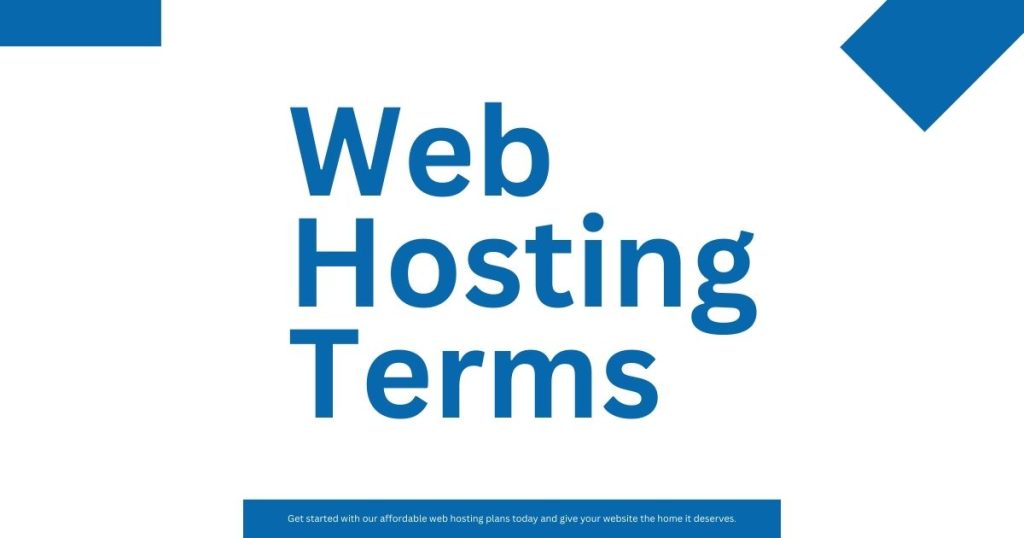Starting your first website can feel like learning a new language. You’ll encounter a flood of technical jargon, from “bandwidth” to “SSL certificates.” It’s easy to feel overwhelmed, but understanding these key web hosting terms is the first step toward making informed decisions for your online presence.
This guide will break down the 10 most common web hosting terms you’ll come across. We’ll explain what each one means in simple, straightforward language, helping you cut through the confusion. By the end of this post, you’ll have the confidence to choose the right hosting plan and manage your website effectively. We’ll cover everything from the space your website occupies on the internet to the security measures that protect it.
1. Domain Name
A domain name is your website’s address on the internet. It’s the unique name that people type into their browser’s address bar to find you, like google.com or wikipedia.org. Think of it as the street address for your digital property. Without a domain name, users would have to remember a complex string of numbers (an IP address) to visit your site, which is far from practical.
Key Components of a Domain Name
- Top-Level Domain (TLD): This is the part of the domain name that comes after the final dot. The most common TLDs are
.com,.org, and.net. There are also country-code TLDs (ccTLDs) like.ukfor the United Kingdom or.cafor Canada, and hundreds of other generic TLDs (gTLDs) like.app,.blog, or.shop. - Second-Level Domain (SLD): This is the unique part of your domain name that you choose. In
hostorbis.com, “hostorbis” is the SLD. This is your brand’s identity online, so it should be memorable, easy to spell, and relevant to your business or purpose.
How to Get a Domain Name
You can register a domain name through a domain registrar or directly through a hosting provider like HostOrbis. Many hosting providers offer a free domain name for the first year when you sign up for a hosting plan, which can be a great way to save on initial costs.
2. Web Hosting
If a domain name is your website’s address, then web hosting is the actual house where your website lives. Web hosting is a service that provides the technology and server space needed for your website to be viewed on the internet. When you purchase a hosting plan, you are essentially renting space on a physical server where you can store all the files, images, and data that make up your website.
When a user types your domain name into their browser, the browser connects to the server where your files are stored. The server then sends the website’s files back to the user’s browser, allowing them to view and interact with your site. Without web hosting, your website wouldn’t be accessible to anyone online.
There are several types of web hosting, each suited for different needs and budgets. The most common types are shared hosting, VPS hosting, dedicated hosting, and cloud hosting. Choosing the right one depends on factors like your website’s traffic, technical requirements, and budget.
3. Bandwidth
In the context of web hosting, bandwidth refers to the amount of data that can be transferred between your website, its server, and your visitors. It’s often compared to a highway—the wider the highway, the more traffic it can handle at once without getting congested.
Every time a visitor loads a page on your site, they are using bandwidth. Data is transferred from the server to the computer to display the text, images, videos, and other content. The total amount of data transferred over a specific period (usually a month) is your bandwidth usage.
Why is Bandwidth Important?
If your website exceeds its allocated bandwidth, two things can happen:
- Overage Fees: Your hosting provider might charge you extra for the additional data transfer.
- Website Suspension: Some hosts might temporarily take your site offline until the next billing cycle begins.
Websites with a lot of high-resolution images, videos, or downloadable files will use more bandwidth than simple, text-based sites. Similarly, a site with thousands of daily visitors will consume more bandwidth than a site with only a few. Many hosting plans, including those from HostOrbis, offer “unmetered” or “unlimited” bandwidth, which is sufficient for most small to medium-sized websites.
4. Disk Space (or Storage)
Disk space, also known as storage, is the amount of server space allocated to your hosting account. This is where all of your website’s files are stored. This includes everything from HTML files and CSS stylesheets to images, videos, databases, and emails.
Think of disk space like the storage on your computer’s hard drive. You have a finite amount of space to store your documents, photos, and applications. Similarly, your web hosting plan comes with a specific amount of disk space.
How Much Disk Space Do You Need?
The amount of disk space you need depends entirely on the size of your website.
- A simple blog with mostly text and a few images might only need a few hundred megabytes (MB).
- An e-commerce site with thousands of high-quality product photos will require significantly more, likely several gigabytes (GB).
- A site with downloadable videos or large software files will need even more space.
When choosing a hosting plan, it’s wise to select one that offers more disk space than you currently need. This gives your website room to grow as you add more content and features over time. Many hosting providers offer generous disk space even on their entry-level plans.
5. Uptime
Uptime is a measure of the percentage of time that a web server is operational and your website is accessible to visitors. It’s a critical metric for a website’s reliability. If a server goes down, your website becomes unavailable, which can lead to lost traffic, sales, and trust.
Uptime is typically expressed as a percentage. For example, an uptime of 99.9% means that the server is expected to be down for no more than about 43 minutes per month. While 100% uptime is the ideal, it’s virtually impossible to achieve due to factors like hardware maintenance, software updates, and unforeseen technical issues.
Most reputable hosting providers, including HostOrbis, offer an uptime guarantee, often 99.9% or higher. This guarantee is a promise that your website will be available for that percentage of time. If the provider fails to meet this guarantee, you may be eligible for a partial refund or account credit. High uptime is essential for any serious website, especially for businesses where downtime can directly impact revenue.
6. SSL Certificate
An SSL (Secure Sockets Layer) certificate is a digital certificate that authenticates a website’s identity and enables an encrypted connection. In simpler terms, it’s a security protocol that creates a secure, private link between a web server and a visitor’s browser.
You can tell if a website has an SSL certificate by looking at the URL.
- A site with SSL will have a URL that starts with
https://. - A site without SSL will start with
http://.
Modern browsers also display a padlock icon in the address bar to indicate a secure connection.
Why is an SSL Certificate Crucial?
- Security: SSL encrypts sensitive information, such as credit card numbers, passwords, and personal details, that is transmitted between the user and the website. This prevents hackers from intercepting and stealing the data.
- Trust: The padlock icon and
https://prefix signal to visitors that your site is secure, which builds trust and confidence. This is especially important for e-commerce sites or any site that collects user information. - SEO: Search engines like Google favor secure websites. Having an SSL certificate can give your site a slight ranking boost in search results.
Many hosting providers, including HostOrbis, offer free SSL certificates (often from Let’s Encrypt) with their hosting plans, making it easy and affordable to secure your website.
7. Control Panel (cPanel)
A control panel is a web-based interface that allows you to manage your web hosting account and website. It provides a user-friendly dashboard with tools and features that simplify server administration, eliminating the need for advanced technical knowledge.
The most popular web hosting control panel is cPanel. It’s known for its intuitive graphical interface and comprehensive set of features. With cPanel, you can perform a wide range of tasks, such as:
- Managing your website’s files using a file manager.
- Creating and managing email accounts associated with your domain.
- Installing website software like WordPress, Joomla, or Magento with one-click installers.
- Managing databases and creating backups of your website.
- Viewing website statistics and monitoring resource usage.
A good control panel makes managing your website much more straightforward. When choosing a hosting provider, check which control panel they offer, as it will be your primary tool for interacting with your hosting environment.
8. Database
A database is an organized collection of data that can be easily accessed, managed, and updated. For dynamic websites, a database is essential for storing and retrieving information. For example, a content management system (CMS) like WordPress uses a database to store all of your site’s content, including blog posts, pages, user comments, and settings.
When a visitor requests a page on your WordPress site, the server queries the database to pull the necessary content and then assembles it into the webpage that is displayed in the browser. Similarly, an e-commerce website uses a database to store product information, customer details, and order history.
The most common type of database used for web hosting is a relational database managed by a system called MySQL. Your hosting control panel, like cPanel, will typically include tools like phpMyAdmin that allow you to manage your databases directly.
9. DNS (Domain Name System)
The Domain Name System (DNS) is often called the “phonebook of the internet.” Its primary job is to translate human-readable domain names (like hostorbis.com) into machine-readable IP addresses (like 192.168.1.1).
Computers and servers identify each other on the internet using numerical IP addresses. However, it would be impossible for humans to remember these long strings of numbers for every website they want to visit. DNS solves this problem by connecting the domain name you type into your browser to the corresponding IP address of the server where the website is hosted.
This translation process, called a DNS lookup, happens in the background almost instantly every time you visit a website. When you register a domain name, you need to point it to your web hosting provider’s nameservers. This tells the DNS system where to find the server that holds your website’s files.
10. CMS (Content Management System)
A Content Management System (CMS) is a software application that allows users to create, manage, and modify content on a website without needing specialized technical knowledge. It provides a user-friendly interface that simplifies the process of building and maintaining a website.
Without a CMS, you would need to write all of your website’s code in languages like HTML, CSS, and JavaScript. With a CMS, you can create and edit pages, add images, and manage your site’s structure using a familiar editor, similar to a word processor.
Popular CMS Platforms
- WordPress: The most popular CMS in the world, powering over 40% of all websites. It’s known for its flexibility, extensive library of themes and plugins, and large community support.
- Joomla: A powerful and flexible CMS that is well-suited for building complex websites and online applications.
- Drupal: A robust CMS known for its strong security and scalability, often used for large, enterprise-level websites.
Most hosting providers, including HostOrbis, offer one-click installers for popular CMS platforms, making it incredibly easy to get your website up and running in minutes.
Your Next Steps
Understanding these fundamental web hosting terms is a major step toward launching and managing a successful website. You’re now better equipped to compare hosting plans, communicate with support teams, and make confident decisions about your online presence. While the world of web hosting can seem complex, these concepts are the building blocks you need to get started.
If you’re ready to take the next step, explore the hosting plans at HostOrbis. We provide reliable hosting with all the features you need, backed by expert support to help you along the way.






